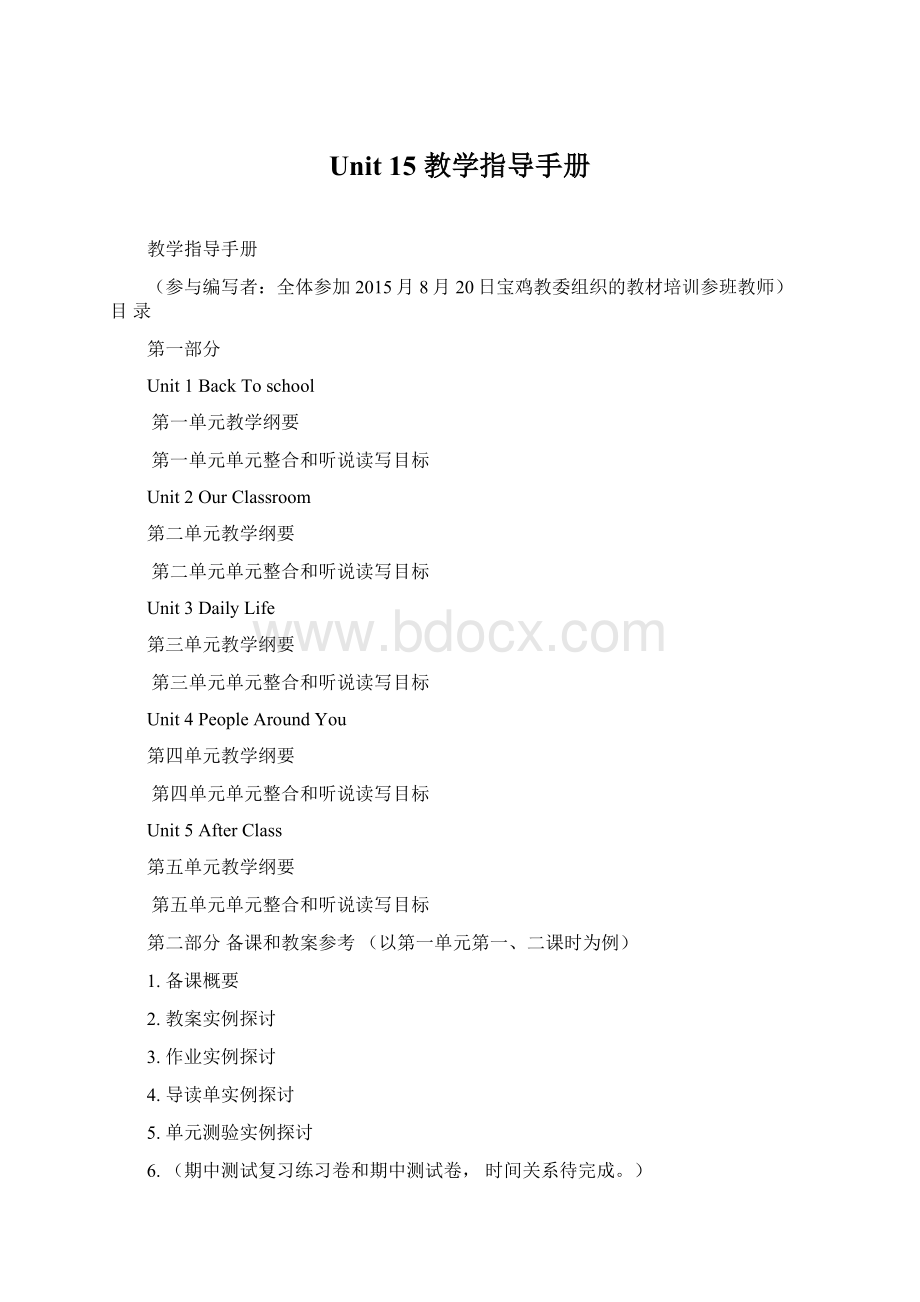 Unit 15 教学指导手册.docx
Unit 15 教学指导手册.docx
- 文档编号:3307147
- 上传时间:2022-11-21
- 格式:DOCX
- 页数:63
- 大小:43.98KB
Unit 15 教学指导手册.docx
《Unit 15 教学指导手册.docx》由会员分享,可在线阅读,更多相关《Unit 15 教学指导手册.docx(63页珍藏版)》请在冰豆网上搜索。

Unit15教学指导手册
教学指导手册
(参与编写者:
全体参加2015月8月20日宝鸡教委组织的教材培训参班教师)
目录
第一部分
Unit1BackToschool
第一单元教学纲要
第一单元单元整合和听说读写目标
Unit2OurClassroom
第二单元教学纲要
第二单元单元整合和听说读写目标
Unit3DailyLife
第三单元教学纲要
第三单元单元整合和听说读写目标
Unit4PeopleAroundYou
第四单元教学纲要
第四单元单元整合和听说读写目标
Unit5AfterClass
第五单元教学纲要
第五单元单元整合和听说读写目标
第二部分备课和教案参考(以第一单元第一、二课时为例)
1.备课概要
2.教案实例探讨
3.作业实例探讨
4.导读单实例探讨
5.单元测验实例探讨
6.(期中测试复习练习卷和期中测试卷,时间关系待完成。
)
第一部分
Unit1Backtoschool
I.教学纲要
教学内容
重点和难点
补充知识
难点处理
语言输出
备注
U1
Backtoschool
GettingStarted1
nationality
Britain
British
France
French
Canada
Canadian
Germany
German
Japan
Japanese
Russia
Russian
befrom/comefrom
I’m_____yearsold.
Nicetomeet/seeyou.
China
Chinese
Italy
Italian
befrom/comefrom
e.g.I’mfromChina.I’mChinese.
IcomefromtheUSA.I’mAmerican
对国家和国籍的了解和朗读。
能够简单介绍自己
能够熟练见面打招呼用语。
GettingStarted2
spell
age
What’syourname?
What’syourEnglishname?
Howdoyouspellyourname?
Areyouastudent?
Yes,Iam.No,I’mnot.
Whereareyoufrom?
Whatnationalityareyou?
Howoldareyou?
spellingn.
spellv.
eg.Canyouspellyourname?
Yes.ItspellsS-A-N-D-Y.
agen.
eg.What’syourage?
能够运用所学内容,与朋友交流,对对方有进一步的了解。
GettingStarted3,4,5
He/She/It______
ItspellsT-O-M.
Whoisit?
It’sLiNing.
Whatnationalityishe?
能够将GettingStarted1和GettingStarted2进行整合,并同桌或小组交流。
Dialogue1
sameadj.
eg.Weareinthesameclass.Weareclassmates.
neighbor(u)rn.
It’stimeforsth.
能够用简短的对话交朋友并且问候朋友。
Dialogue2
greet
absent
beabsentfrom
I’msorry/glad/excited/pleasedtohearthat.
greetingn.
greetv.
eg.greeteachother
absentadj.
eg.beabsentfromclass/work/school
注意问候渗透。
能够问候朋友并且表达自己的情感。
Item1
September
bebackatschool
middleschool
proud
subject
history
geography
biology
like…best
dowell(in)
believe
Iseverythinggoingwellwithyou?
HowImissyou!
prouda.
eg.She’sproudofherself.She’sproudofherschool.
dowellin/begoodat
eg.Suedoeswellingeography,andsheisgoodatmaths,too.
believev.
eg.IbelieveIcanactoutthedialogue.
初步了解书信的结构。
1.能够熟练进行自我介绍,也可以通过书信以及e-mail交笔友。
2.能够介绍我的新学校。
Item2
introduce
introduceAtoB
international
gentleman
language
schoolnewsonTV
on/intheteam
headteacher
thegirlwithglasses
theboyinred
overseas
welcome
haveagoodtime
introducev.
eg.Canyouintroduceyourselftome?
overseasadj.
welcomen.
eg.Let’sgivethemawarmwelcome.v.
eg.Theteachercametowelcomeus.
将tobe从第一人称改写为第三人称单数形式。
能够用第三人称单数形式介绍他人(姓名,国家,国籍,特征)。
Item3
astudentofaninternationalschool
begoodat
computerengineer
作为介绍注意有其开头和结尾,而且要首尾呼应。
能够介绍自己的家庭情况(家庭成员及其他)。
Culturecorner
attheageofsix
primaryschool
highschool
secondaryschool
theSpringFestival
anewschoolyear
compare…with…
monitor
classteacher
headmaster
fixedclassroom
teachingbuilding
schoolgate
schoolyard
fence
dormitory
YoungPioneer
middleschool
了解中西方的学校生活。
本部分要求学生能看懂,教师能用中文解释。
Grammar:
pronouns:
subjectivecase,objectivecase,possessiveadjectives&possessivenouns
II.单元整合及分课时口语和书面要求:
共6课时。
单元课题
Unit1BacktoSchool
课时
授课内容
课时课题
听说目标
读写目标
第一课时
GS1+D1
MeetingNewFriends
1.能介绍自己,如自己的姓名、年龄。
了解国家和国籍(叙述)
2.能交新朋友(对话)
能正确书写和默写本课所学的单词和打招呼语和
除China、Chinese、theUSA,American外,其余有关国家和国籍的单词本课只做认知要求。
能做书面翻译题。
能书面补充对话。
第二课时
GS2/3+D2
Makefriends
能询问同学的姓名国籍等信息(对话),并用获得的信息将同学介绍给大家(叙述)。
能就所获信息介绍同桌、教师......
第三课时
Item1+culturecorner
Mynewschool(friendsandschoolsubjects&activities)
1.能跟录音模仿Item1,正确朗读并表演。
2.能仿照Item1说说你自己的新学校。
能在口头表达的基础上,写自己的新学校。
(书信格式,不做要求)
第四课时
GS4/5+Item2
Introduction
1.能跟录音模仿Item2,做到能用正确的语音语调朗读并表演。
2.能口头介绍朋友(姓名,国家,国籍,特征)
能完成练习册中的练习
第五课时
Item3+DIY2
Jimmy’s/Myfamily
能朗读Item3
1.能完成Item3的阅读理解
2.能书面介绍你的家庭成员。
第六课时
Grammar、Summary(MessageBox、GameZone)
Revision
能就所给信息做口头介绍
完成单元测试
Unit2OurClassroom
I.教学纲要
教学内容
重点和难点
补充知识
难点处理
语言输出
备注
U1
Backtoschool
GettingStarted1
stationeryn.[U]
What’sthis?
It’sateacher’sdesk.
What’sthat?
It’sachair.
Whatarethese?
Theyaredesks.
Whatarethose?
Theyarechairs.
能听懂并且能够用GS1的对话进行交流。
GettingStarted2
pencil
ballpointpen
CD/DVDplayer
textbook
dictionary
copier
printer
IsthisaTVset?
No,itisn’t.It’sacomputer.
photocopiern.
能听懂并且能够用GS2的对话进行交流。
GettingStarted3
能听懂并且可以自己介绍自己的学习用具。
GettingStarted4
eraser
What’sthis/that?
Whatarethese/those?
能熟练掌握以下结构:
A:
What’sthis/that?
B:
It’sapencil/ruler/(an)eraser/school-bag/ballpointpen.
A:
Whatarethese/those?
B:
Theyarepencils/schoolbags/ballpointpens.
GettingStarted5
onthedesk
inthebox
inthefrontoftheclassroom
onadesknearthewindow
theteacher’sdesk
Whereisthemap?
It’sonthewall.
cf.infrontof
熟练掌握一些介词,并能够运用Whereis...?
It’s....
GettingStarted6
biologylab
theteachers’office
attheendofthecorridor
cf.theteacher’sdesk
corridorn.
eg.Studentsarewaitinginthecorridor.
能够将GS1--GS5综合运用。
Dialogue1
workbook
Aretheseyourworkbooks?
No,theyaren’t.
Lookatthoseworkbooksonthedesk.AretheyJohn’sworkbooks?
Yes,theyare.
prepositionalphrasesasanattributive:
theexercisebooksonthedesk桌上的练习本theteacher’sdeskinClassOne一班的讲台
thepinkexercisebookunderthechair椅子下面粉红色的练习本
thebooksintheschoolbag书包里的书
能够表演对话并且自己编对话。
Dialogue2
seat
theoneontheleft
havealook
thethirdonebesidethewindow
lookv.
E.g.haveawash=wash
haveaswim=swim
能够表演对话并且自己编对话。
Item1
bythewindow
tidy
underthepencilbox
beside/nexttothewindow
tidyadj.
e.g.cleanandtidy
onduty值日e.g.:
Jimisondutytoday.吉姆今天值日。
1.能介绍mydesk,或者his/herdesk。
2.能将自己所叙述的短文与同桌改成对话形式。
Item2
inall
accountant
publicadj.
graden.
I’minClassOne,GradeSix.
altogether
astudentof…的一名学生。
e.g.:
astudentofYaleUniversity耶鲁大学的一名学生
英语中,我们通常先说小的内容,再说大的内容。
e.g.:
Myaddressis25Chang’anStreet,Beijing.我的地址是北京市长安街25号。
1.能够复述Item2
2.能够将Item2改成对话形式表演。
3.能够模仿Item2进行myclassmates的介绍。
Item3
bright
onthesecondfloor
thefrontwindow
thebackwall
projector
specimen
inthecornersofthelab
butterfly
showsb.sth.
grey
bekindtosb.
specimenn.([pl.]specimens)
cornern.
e.g.TheTVstation’snameisinthecornerofthescreen.
butterflyn.([pl.]butterflies)
showsth.tosb.
在英国,在一楼称onthegroundfloor,在二楼称onthefirstfloor,在三楼称onthesecondfloor然后以此类推。
而在美国,在一楼称thefirstfloor,在二楼称onthesecondfloor以此类推。
1.能熟读并复述Item3。
2.能够模仿Item3,介绍Mybedroom。
Culturecorner
afixedclassroom
wait....for...
attheendof...
Grammar:
Presenttense:
tobe
Demonstrativepronouns:
this,that,these,those
Possessiveadjectives:
my,your,his,her,its,our,your,their
Prepositions:
in,on,beside,at,in(the)frontof
II.单元整合及分课时口语和书面要求:
共6课时。
单元课题
Unit2OurClassroom
课时
授课内容
课时课题
听说目标
读写目标
第一课时
GS1~4+MS2,3+Dialogue1
IdentifyingStationery&classroomobjects
1.能在理解和运用this,that/these,those的区别
2.能说出常用文具的名称及其单复数形式。
3.能听懂Dialogue1
4.能背诵Dialogue1
5.能和同桌做对话,说说文具和教室里教学设备。
1.能正确书写和默写本课出现的文具以及教学用具的名称及其单复数形式。
2.能就划线部分提问
3.能做翻译题
4.能完成对话。
第二课时
GS5~6+MS1,4,5+Dialogue2
Talkingaboutpossessionsandpositions
1.能表述方位
2.能表述物品的所有者
3.能听懂,并模仿朗读Dialogue2
4.能背诵Dialogue2
5.能模仿Dialogue2自编对话。
1.能正确理解方位介词,并完成介词填空。
2.能在口头基础上将自编小对话落实到笔头。
第三课时
Item1
Betty’sDesk
1.能听懂并模仿朗读Item1
2.能模仿练习将叙述体改成对话体。
1.能完成就划线部分提问练习。
第四课时
Item2+CultureCorner
MyClassroom
1.能听懂并模仿Item2
2.能口头描述自己的教室。
1.能通过CultureCorner的阅读,知道英美国家教室和我们教室的不同之处。
2.能书面描述自己的教室。
第五课时
Item3
OurBiologyLab
1.能熟读Item3
2.要求有能力的学生能背诵Item3
1.能完成Item3的阅读理解。
第六课时
Grammar、Summary(MessageBox、GameZone)
Revision
Unit3Dailylife
教学纲要
教学内容
重点和难点
补充知识
难点处理
语言输出
备注
U3
Daily
life
GettingStarted1
1.Aboutthetime
--Whattimeisit?
--It’seighto’clock.
It’sfivepasteight./It’seightfive.
It’ssixminutespasteight.
It’stenpasteight./It’seightten.
It’saquarterpasteight./It’seightfifteen.
It’shalfpasteight./It’seightthirty.
It’stwenty-fivetonine./It’seightthirty-five.
It’saquartertonine./It’seightforty-five.
It’selevenminutespastnine.
It’ssixminutestonine.
2.Aboutthedailyactivities
It’stimeforsports/bed/class.
Whattimeisit?
=What’sthetime?
It’stimetodosth.
1.所有的时间都可以用“小时+分钟”直接读2.如果所表述的时间在半小时之内,可以用“分钟+past+小时”3.如果所表述的时间在半小时之外,可以用“(相差的)分钟+to+(下一)小时”4.如果所表述的时间恰好为半小时,可以用“half+past+小时”5.如果分钟不能被5整除,分钟数字后要加minute(s)
(MessageBox5)
It’stimefor…结构中for后面用名词
能够熟练说出时钟上的时间。
GettingStarted2&3
1.Aboutschoolsubjects
politics,chemistry,physics,biology,history,geography,IT,
--Areyougoodat…?
–I’mafraidI’mnot.
--Whichsubjectareyougoodat?
--….
IT(informationtechnology)
begoodatsth./doingsth.
能够用对话方式交流探讨喜欢或擅长的学科。
GettingStarted4
1.Aboutdailylife/sparetimeactivities
weekend/atweekends=everyweekend,piano,garden,chess,watchTV,goswimming,playthepiano,playchess,playbasketball,workinthegarden,rideahorse
2.Presenttense:
todo
atweekends=onweekends
play后面加乐器的时候,必须用the,而运动前不能用the。
能够以业余生活为话题进行简单对话。
Dialogue1
1.dailyroutine,canteen,begin,never,getup,belatefor
2.Presenttense:
todo
3.FrequencyAdverbs:
always,usually,often,sometimes,occasionally,never
4.Wh-Question(Whattime,When,Where)
频率副词在句子中位置(MessageBox5)
能就自己的日常生活情况做较长对话
Dialogue2
1.cup,grandparent.once,stay,spend,together,a
- 配套讲稿:
如PPT文件的首页显示word图标,表示该PPT已包含配套word讲稿。双击word图标可打开word文档。
- 特殊限制:
部分文档作品中含有的国旗、国徽等图片,仅作为作品整体效果示例展示,禁止商用。设计者仅对作品中独创性部分享有著作权。
- 关 键 词:
- Unit 15 教学指导手册 教学 指导 手册
 冰豆网所有资源均是用户自行上传分享,仅供网友学习交流,未经上传用户书面授权,请勿作他用。
冰豆网所有资源均是用户自行上传分享,仅供网友学习交流,未经上传用户书面授权,请勿作他用。


 如何打造酒店企业文化2刘田江doc.docx
如何打造酒店企业文化2刘田江doc.docx
